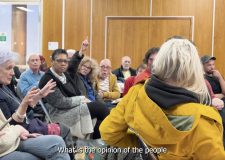News: Homes fit for local people
Millions of pounds are being spent trying to ensure thousands of council tenants have better homes. Frank le Duc finds out more
The age and condition of houses and flats in Brighton and Hove have been a cause for concern for some years. The shortage of housing and the effects of that shortage on house prices and rent levels have also troubled many people. Efforts are being made to tackle these issues despite the pressure on the public purse.

On Thursday 13 February councillors are expected to recommend spending on housing totalling £65 million – much of it on a series of substantial projects – for the financial year from April. About £37 million is expected to be earmarked for the day-to-day work involved in managing, maintaining and improving about 12,000 homes owned by Brighton and Hove City Council. And about £28 million is to be set aside for longer-term schemes.
The £28 million capital spending will pay for much-needed new lifts in blocks of flats, a major rewiring programme and new windows.
It will also cover fire safety improvements, energy efficiency schemes and the installation of more solar panels. Older sheltered housing will be upgraded and work is expected to start on building more council housing.
New housing has already been agreed for Brooke Mead in Albion Street, Brighton. Forty-five “extra care” homes there – similar to sheltered housing – have been given planning permission and funding approval. The scheme even attracted a grant from a national organisation, the Homes and Communities Agency.
It follows the opening last year of Balchin Court – the 12 flats and three houses built in Wellington Road, Brighton, on the site of the demolished Ainsworth House. These were the first council homes built in Brighton for about 30 years. The schemes can make only a tiny dent in a housing waiting list of about 16,000 people but they are part of a bigger strategy to reduce the list.
Most of the £65 million budgeted for housing – almost £58.5 million – will be funded by tenants’ rents and service charges and from commercial and garage rents. The funding for the big money schemes includes £1.3 million from the Housing Revenue Account (HRA) reserves. Some of the funding proposals, including new and higher charges, have caused controversy.
IMPROVING LIVES
Councillor Bill Randall, chairman of the council’s Housing Committee, said: “This investment will improve tenants’ lives and their health and wellbeing. It will help reduce energy bills and it will tackle inequality and the effects of welfare reform through social and financial inclusion work. Our plans for the year include starting work on 45 extra-care flats for older people with supported housing needs. It will be the biggest council housing scheme built in our city for many years.”
He said that, in response to requests from sheltered housing residents for an intensive management service, it is proposed that their service charges will be increased. The rise will be the first since 2003. The charges are proposed to go up by £2.21 a week from April and by £2.43 a week in each of the following two years (2015-16 and 2016-17). Housing benefit is expected to cover the rise for all but 73 of the 855 tenants affected.
The council said that proposed average sheltered housing weekly charge of £98.55 for rent and services is below the average charge set by housing associations locally and by most other councils. The service charge proposals were discussed with the residents’ Sheltered Housing Action Group. If approved, they will be a central part of the planned reorganisation of the council’s sheltered housing. Residents agreed to discuss a programme for change at their next meeting.
“If someone lives at the top of a high-rise block then use of a lift is not an optional extra”
Councillor Randall said: “Brighton and Hove is one of the few councils in England still providing site-based managers at sheltered housing schemes. It is a service highly valued by residents and is central to our aim to keep older people independent for as long as possible, allow them to lead fulfilled lives and take pressure off the health and other services.”
The lift replacement programme is being speeded up after pressure from tenants. It had been scheduled to take ten years. It should now take seven years, with more money having been budgeted for the work. In the year from April new lifts are due to be put in at Hereford Court, Theobald House, Thornsdale, Philip Court, Sanders House and Nettleton Court. And a two-year programme is expected to start at Leach Court.
New charges of 85p a week are proposed to cover the cost of lift maintenance and an average of £1 a week for communal lighting in non-sheltered flats. The cost of providing these services has previously been spread across all council rents in Brighton and Hove. The council said that under the proposals those costs would be met only by the people who use them.
Councillor Dawn Barnett asked at a recent council meeting whether those living on the ground floor would have to pay as they would not need to use the lift. She said: “If someone has been placed in accommodation at the top of a high-rise block of flats then use of a lift is not exactly an optional extra. And what about tenants who live in a high-rise block but use the stairs to access their flat? It hardly seems fair to make them pay the charge.”
“SPITEFUL ATTACK”
She criticised the “mean Green charges” and described them as “a spiteful attack on some of our most vulnerable residents”. Her Conservative colleague, Councillor Garry Peltzer Dunn, told Latest 7: “We do have concerns around a number of aspects of this year’s HRA budget. Firstly, the Green administration is setting a dangerous precedent by breaching the long-held principle that tenants’ rents should be ring-fenced for spending on other housing-related works and services.
“There will be tenants who have been waiting a long time for a new lift in their block or replacements for old draughty windows, for example. They will be extremely unhappy that part of their rent is being used instead to plug gaps in the council’s main general fund budget.” The Conservatives are concerned that the proposals could mean that council tenants’ rents will unlawfully be subsidising services for the wider – and often wealthier – population. The Greens say that they are sticking to the law and following the example of other councils.
Councillor Peltzer Dunn said: “Largely as a result of taking money out of the HRA, a number of new service charges are being proposed that I am very concerned about. For example, a new £200 annual charge for mobility scooter storage which will be a huge blow to some of our most vulnerable elderly residents. If they were being introduced to plug a hole in the budget then you could possibly understand the reasoning but, with a projected underspend on the HRA budget of over £300,000, there is no hole to plug.”
Councillor Randall said that the lift and communal lighting charges would mean that those services were funded more fairly. He said: “Housing benefit would cover the increase for all but 1,467 of the 5,410 tenants affected.
“The financial inclusion team will work with all residents paying the new charges and sheltered housing residents paying the higher charges to ensure they claim all their benefit entitlement and to identify ways they can save money on energy and other bills. We believe some of those residents would move into housing benefit as a result of the changes.”
The work over the past six to seven years to upgrade council houses and flats in Brighton and Hove follows years of historic underinvestment. In part, this was because rents had been kept as low as possible. And there was a belief that the council would be forced to dispose of those properties not purchased by tenants under the right to buy scheme.
Moves to improve the council’s housing stock have had the broad agreement of all three parties – the Greens, Conservatives and Labour. But as the budget for the coming year is showing, there are differences of opinion as councillors and officials struggle to tackle real problems, affecting thousands of people, and balance the books.




















